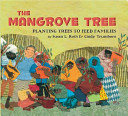 The Mangrove Tree: Planting Trees to Feed Families
The Mangrove Tree: Planting Trees to Feed Families
Written by Susan L. Roth
Illustrated by Cindy Trumbore
Lee & Low, 2011
ISBN: 978-1600604591
The Mangrove Tree: Planting Trees to Feed Families is a visual delight that tells the story of Dr. Gordon Sato’s quest to change the lives of the Hargigo people of Eritrea, Africa. Susan Roth, well-known for her textually-rich collages, and Cindy Trumbore team up to create an exquisite, textually-rich visual text. This two-pronged, descriptive, written text tells the story of how one man set about to help the people of Hargigo Village in Eritrea, Africa, a place where the people lacked enough food to feed themselves and their animals. On the left side of each page is a cumulative text; on the right side is the narrative of this one man’s vision. Dr. Gordon Sato, an American cell biologist, had an idea—planting mangrove trees by the shore of the salty Red Sea. Dr. Sato realized the mangrove tree was the perfect delivery system for helping the environment and the Hargigo villagers. The trees would remove carbon dioxide and give off oxygen; the roots would hide small creatures and attract bigger fish for the fisherman; the dry branches would serve as fuel for cooking fires; the leaves would provide food for the animals; and, in turn, well-fed animals would produce more livestock for milk and food for the villagers. Dr. Sato set out to make his idea a reality.
Readers will want to know more about Gordon Sato and the villagers of Hargigo. As a teenager, Sato and his family were sent to Manzanar, an internment camp, during WW II. There, he learned how to grow vegetables in that desert region to supplement the canned Spam they were fed three times a day. Sato saw Hargigo as the perfect place to intersect his interests, knowledge, and desire to help others. The plantings along the shoreline near Hargigo became known as the Mangrove Memorial Garden, where one tree was planted for every villager killed in a 1975 massacre. Since the start of the Manzanar Project, as the mangrove tree project is called, nearly one million mangrove trees on the coast of Eritrea have been planted and Sato has become a “maritime Johnny Appleseed” (National Geographic, February 2007, retrieved July 2, 2012).
Other books that share this theme of helping communities improve their lives through environmental and agricultural projects include: Beatrice’s Goat (Page McBrier, 2004), One Hen—How One Small Loan Made a Big difference (Kate Milway, 2008), Mama Miti: Wangari Maathai and the Trees of Kenya (Donna J. Napoli, 2010), and Ryan and Jimmy and the Well in Africa that Brought Them Together (Herb Shoveller, 2008). Further sources for information regarding The Manzanar Project can be found at the following websites:
The Manzanar Project
YouTube
National Geographic
T. Gail Pritchard, University of Arizona, Tucson
WOW Review, Volume V, Issue 1 by Worlds of Words is licensed under a Creative Commons Attribution-NonCommercial-ShareAlike 4.0 International License. Based on work at https://wowlit.org/on-line-publications/review/v-1/

Thank you, Judi Moreillon, for this wonderful and thorough review.
I appreciate the connection to other books about the effects of war on children and hope, as more titles with international settings are published, young US readers’ perspective and understanding of world events continues to deepen.
Interested teachers can find a discussion guide for MY BROTHER’S SHADOW on the publisher’s website that includes a bibliography of WWI titles. http://media.us.macmillan.com/discussionguides/9780374351229DG.pdf
For teachers, students and ‘history nerds’ with an interest in primary sources I would like to recommend the website of the German History Institute in Washington, D.C.. Their digital library links to documents, images, etc., sorted by time periods, with translations and captions in English. http://germanhistorydocs.ghi-dc.org/